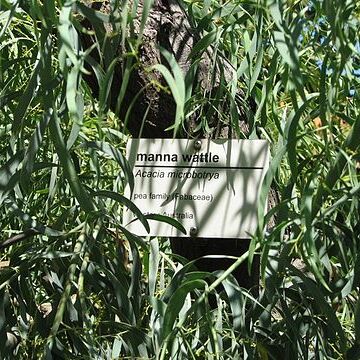Sturdy shrub or tree 3–8 (–10) m high, with 1–3 (–4) main trunks, crowns bushy, often suckering. Bark light-or dark-grey to black, smooth to rough and longitudinally fissured. Branchlets glabrous. Phyllodes patent to pendulous, narrowly elliptic to oblanceolate, shallowly to obviously falcately recurved, (7–) 8–15 (–18) cm long, (5–) 8–18 (–25) mm wide, acute to acuminate, thinly coriaceous, grey-green to subglaucous or glaucous but commonly aging green glabrous, 1‑nerved per face, obscurely penninerved; gland not prominent, 2–30 (–40) mm above pulvinus. Inflorescences racemose; raceme axes mostly 1–6 (–8) cm long, sparsely to densely appressed-puberulous with yellow or white hairs that are often absent at base of axes; peduncles 2–6 mm long, with indumentum as on raceme axes; heads showy, globular, 3–6 mm diameter at anthesis (dry), 20–35 (–40)-flowered, cream to pale yellow or bright lemon yellow; bracteole laminae golden-fimbriolate. Flowers 5-merous; sepals united. Pods moniliform to submoniliform, 9–20 (–24) cm long, (5–) 6–9 mm wide, thinly coriaceous, reddish brown to blackish (dry), glabrous. Seeds oblong to elliptic, 5–8 mm long, 3–5 (–6) mm wide, subshiny, dark brown to black, smooth or minutely pitted, ½ or more commonly wholly encircled by a light brown to dark red-brown, slender funicle; aril clavate.
More
A small evergreen tree 2-6 m tall. It can be up to 5 m wide. The bark is rough at the base but otherwise the stem is erect and smooth. The branches are slightly angular. The leaves (phyllodes) are green-grey and hang down. They are curved. The leaves vary a lot in shape and size. They are mostly 7-13 cm long by 0.6-1.5 cm wide. They taper towards the end. The flowers are small bright yellow sprays. They look like small bunches of grapes. About 20 small flowers with stalks 3-4 mm long occur as a ball. About 3-25 of these heads are on a branched stalk. The pods are dark brown and with fine veins. They are 10-20 cm long by 0.2-0.7 cm wide. The pods are constricted between the seeds. The pods have slightly thickened edges. The seeds are black. They are oblong and 5-7 mm long by 3-4 mm wide.
Grows in a range of habitats but is commonly found on clay-loam or sandy loam flats, often near watercourses; the Dandaragan variant favours sandy soil. Often locally common and often found along degraded road verges.
More
It is a temperate plant. A native of south west Western Australia. It occurs in sandy loams. It needs well drained sites. It prefers open sunny positions. It is drought resistant. It could be damaged by frost.
Found in a variety of habitats but often on clay loam or sandy loam flats, often near watercourses, in Eucalyptus woodland.


